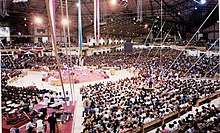Worship service (evangelicalism)
In Evangelical christianity, a worship service or service is a time when believers meet to praise, worship, pray God and receive a teaching (sermon) based on the Bible. It can take place with the church or with the family. Meetings can be held on weekdays, but Sunday's has a special connotation. In Anglican and other more traditional Protestant churches, worship service is often framed by the liturgy for the exercise of the sacraments. In the evangelical churches, worship service is more seen as an act of adoration of God, with a more informal conception.
Origin
The worship service is a practice of Christian life that has its origins in the Jewish worship.[1] Jesus Christ and Paul of Tarsus taught a new form of worship of God.[2] In Scripture, Jesus meet together with His disciples to share teachings and discuss topics,[3] praying and singing hymns;[4] in the "Acts of the Apostles", we read that the early Christians also had this habit. In the first letter to the Corinthians, Paul of Tarsus made clear the principal elements of the Christian worship, namely praise, preaching, offering, the lord's Supper.[5]
Form



Worship service in Evangelical churches is seen as an act of God's worship.[6] There is no liturgy, the conception of worship service is more informal.[7] It is usually run by a Christian pastor. It usually contains two main parts, the praise (Christian music) and the sermon, with periodically the lord's Supper. [8] [9] [10][11]
With the 1960s' charismatic movement, a new conception of praise in worship, such as clapping and raising hands as a sign of worship, took place in many evangelical denominations.[12]
In the 1980s and 1990s, contemporary Christian music, including a wide variety of musical styles, such as Christian Christian Rock and Christian Hip Hop, appeared in the praise. [13][14] [15]
In the 2000s and 2010s, digital technologies were integrated into worship services, such as the video projectors for broadcasting praise lyrics or video, on big screens. [16][17] The use of social media such as YouTube and Facebook to retransmit live or delayed worship services, by Internet, has also spread. [18]Online giving has become a common practice in several churches. [19][20]
Places of worship


Places of worship are usually called "church building" or "temples".[21][22][23][24] In some megachurches, the place of worship is called "campus".[25][26] For evangelicals, the building is not sacred.[27] Some services take place in auditoriums or multipurpose rooms with few religious symbols.[28][29][30]
House church
House church meetings have also spread to parts of the world.[31] In China, it would be 52 million people in 2010.[32] The worship services broadcast by Internet have accentuated this trend.[33]
Megachurches
Worship services take on impressive proportions in the megachurches (churches where more than 2,000 people gather every Sunday. In some of these megachurches, more than 10,000 people gather every Sunday. The term gigachurch is sometimes used.[34][35] For example, Lakewood Church (United States) or Yoido Full Gospel Church (South Korea).[36]
Groups
IFES are groups of Evangelical students coming together on campuses in 150 countries around the world to share their ideas on the Bible.[37]
Full Gospel Business Men's Fellowship International meetings are held in restaurants or hotels and Christian businessmen talk about their faith.[38]
Threats
In some Muslim or Communist countries, it is difficult or even forbidden for Christians to gather publicly. Only a few churches approved by the government can gather legally.[39][40][41] The persecution leads to the development of house churches, as in China, with the movement of Evangelical House churches in China.[42]
The meetings take place in private homes, in secret and in "illegality". Open Doors, an evangelical NGO, claims that this is the case for hundreds of millions of Christians in the world.[43] Each year, It publishes the "World Watch List of Christian Persecution" and testifies to the hardships of some believers.
Criticism
In some Evangelical churches, offerings, composed of the tithe and gifts, occupies a lot of time in the worship services.[44] The frequency and value of donations are monitored.[45][46] There are also certain financial discourses that oblige the believer to give the tithe (10%), as a mandatory tax to avoid the curses of God and the attacks of the devil, even poverty.[47][48] For many analysts,[49][50] this kind of extremist teaching is compared to a religious business. This extremism is fought by pastors [51] and organizations, like the National Council of Evangelicals of France, in France.[52]
References
- ↑ BBC, Christian worship, bbc.co.uk, UK, June 23, 2009
- ↑ Geoffrey Wainwright, The Oxford History of Christian Worship, Oxford University Press , USA, 2006, p. 465
- ↑ Amy-Jill Levine, Dale C. Allison Jr., John Dominic Crossan, The Historical Jesus in Context, Princeton University Press, USA, 2009, p. 2
- ↑ Mark 14.26, Matthew 26.30; see John J. Pilch, "A Cultural Handbook to the Bible", Wm. B. Eerdmans Publishing, USA, 2012, p. 263
- ↑ John Paul Heil, The Letters of Paul as Rituals of Worship, Casemate Publishers, USA, 2012, p. 38, 41
- ↑ Gerald R. McDermott, The Oxford Handbook of Evangelical Theology, Oxford University Press, UK, 2013, p. 311
- ↑ Roger E. Olson, The Westminster Handbook to Evangelical Theology, Westminster John Knox Press , UK, 2004, p. 284
- ↑ Bruce E. Shields, David Alan Butzu, Generations of Praise: The History of Worship, College Press, USA, 2006, p. 307-308
- ↑ Robert Dusek, Facing the Music, Xulon Press, USA, 2008, p. 65
- ↑ Flora Genoux, Comment l'Église évangélique conquiert les Français, lemonde.fr, France, February 02, 2012
- ↑ Rémy Chhem, Marc-André Morency, Le culte du dimanche à l'Église évangélique baptiste de Québec, IPIR, Canada, December 13, 2011
- ↑ Robert H. Krapohl, Charles H. Lippy, The Evangelicals: A Historical, Thematic, and Biographical Guide, Greenwood Publishing Group, USA, 1999, p. 171
- ↑ Suzel Ana Reily, Jonathan M. Dueck, The Oxford Handbook of Music and World Christianities, Oxford University Press, USA, 2016, p. 443
- ↑ Mathew Guest, Evangelical Identity and Contemporary Culture: A Congregational Study in Innovation, Wipf and Stock Publishers, USA, 2007, p. 42
- ↑ Don Cusic, Encyclopedia of Contemporary Christian Music: Pop, Rock, and Worship: Pop, Rock, and Worship, ABC-CLIO, USA, 2009, p. 85-86
- ↑ Christina L. Baade, James Andrew Deaville, Music and the Broadcast Experience: Performance, Production, and Audience, Oxford University Press, USA, 2016, p. 300
- ↑ AARON RANDLE, Bucking a trend, these churches figured out how to bring millennials back to worship, kansascity.com, USA, December 10, 2017
- ↑ Mark Ward Sr., The Electronic Church in the Digital Age: Cultural Impacts of Evangelical Mass Media [2 volumes]: Cultural Impacts of Evangelical Mass Media, ABC-CLIO, USA, 2015, p. 78
- ↑ Michael Gryboski, Millennial-Majority Churches Detail Challenges, Success Stories in Growth and Finances, christianpost.com, USA, June 18, 2018
- ↑ Ghana News Agency, Asoriba launches church management software, businessghana.com, Ghana, February 3, 2017
- ↑ D. A. Carson, Worship: Adoration and Action: Adoration and Action, Wipf and Stock Publishers, USA, 2002, p. 161
- ↑ Jörg Stolz, Olivier Favre, Caroline Gachet, Emmanuelle Buchard, Le phénomène évangélique: analyses d'un milieu compétitif, Labor et Fides, Switzerland, 2013, p. 99
- ↑ Anne C. Loveland, Otis B. Wheeler, From Meetinghouse to Megachurch: A Material and Cultural History, University of Missouri Press, USA, 2003, p. 149
- ↑ Harold W. Turner, From Temple to Meeting House: The Phenomenology and Theology of Places of Worship, Walter de Gruyter, Germany, 1979, p.258
- ↑ Justin G. Wilford, Sacred Subdivisions: The Postsuburban Transformation of American Evangelicalism, NYU Press, USA, 2012, p. 78
- ↑ Anne C. Loveland, Otis B. Wheeler, From Meetinghouse to Megachurch: A Material and Cultural History, University of Missouri Press, USA, 2003, p. 2
- ↑ Marie-Claude Malboeuf, Au pays des églises invisibles, lapresse.ca, Canada, June 23, 2011
- ↑ Jörg Stolz, Olivier Favre, Caroline Gachet, Emmanuelle Buchard, Le phénomène évangélique: analyses d'un milieu compétitif, Labor et Fides, Switzerland, 2013, p. 104
- ↑ Jeanne Halgren Kilde, Sacred Power, Sacred Space: An Introduction to Christian Architecture and Worship, Oxford University Press, USA, 2008, p. 193
- ↑ Keith A. Roberts, David Yamane, Religion in Sociological Perspective, SAGE , USA, 2011, p. 209
- ↑ Allan Heaton Anderson, " An Introduction to Pentecostalism: Global Charismatic Christianity", Cambridge University Press, UK, 2013, p. 104
- ↑ Allan Heaton Anderson, " An Introduction to Pentecostalism: Global Charismatic Christianity", Cambridge University Press, UK, 2013, p. 147
- ↑ Candy Gunther Brown, Mark Silk, The Future of Evangelicalism in America, Columbia University Press, USA, 2016, p. 78
- ↑ Sam Hey, Megachurches: Origins, Ministry, and Prospects, Wipf and Stock Publishers, USA, 2013, p. 265
- ↑ Ed Stetzer, Megachurch Research - Terminology, christianitytoday.com, USA, October 9, 2008
- ↑ Alicia Budich, From Megachurch to "Gigachurch", cbsnews.com, USA, April 6, 2012
- ↑ IFES, OUR PEOPLE, ifesworld.org, UK, accessed January 27, 2018
- ↑ Vinson Synan, Amos Yong, Global Renewal Christianity: Europe and North America Spirit-Empowered Movements: Past, Present and Future, Charisma Media, USA, 2017, p. 26
- ↑ Ali Amar, Le calvaire des Marocains chrétiens, slateafrique.com, France, April 21, 2011
- ↑ Farid Alilat, Jésus-Christ en terre d'Algérie, jeuneafrique.com, France, May 16, 2005
- ↑ Le Monde.fr with Reuters, Arrestations de chrétiens au Tibet par les autorités chinoises, lemonde.fr, France, December 13, 2011
- ↑ Brian Stiller, Evangelicals Around the World: A Global Handbook for the 21st Century, Thomas Nelson, USA, 2015, p. 328
- ↑ Le Figaro, Plus de 2000 chrétiens sont morts persécutés en 2013, lefigaro.fr France, January 08, 2014
- ↑ Marie-Claude Malboeuf, Jean-Christophe Laurence, Églises indépendantes: le culte de l'argent, lapresse.ca, Canada, November 17, 2010
- ↑ Yannick Fer, Le système pentecôtiste de gestion de l'argent : Entre illusion subjective et rationalité institutionnelle, Congrès de l'association française de sociologie (AFS), France, 2011, p. 7
- ↑ Sophie Bouillon, Nigeria "God will send you a text message to thank you", liberation.fr, France, April 11, 2014
- ↑ Raoul Mbog, Le juteux business du pasteur évangélique Dieunedort Kamdem, lemonde.fr, France, December 25, 2015
- ↑ Venance Konan, Eglises évangéliques d`Abidjan - Au nom du père, du fils et... du business, Le Nouveau Réveil, Côte d'Ivoire, May 10, 2007
- ↑ Harding Djakou Chati, Nouveaux lieux de culte en Afrique : qui fait bien son travail, prie au moins 100 fois, jeuneafrique.com, France, November 17, 2015
- ↑ Jean-Christophe Laurence, Journal lapresse.ca, Le business religieux, Canada, November 17, 2010
- ↑ AFP, Le ruineux Evangile des "théologiens de la prospérité", lepoint.fr, France, March 26, 2013
- ↑ Henrik Lindell, Théologie de la prospérité : quand Dieu devient un distributeur de miracles, lavie.fr, France, August 8, 2012
Content in this edit is translated from the existing French Wikipedia article at fr: Culte (évangélisme); see its history for attribution.